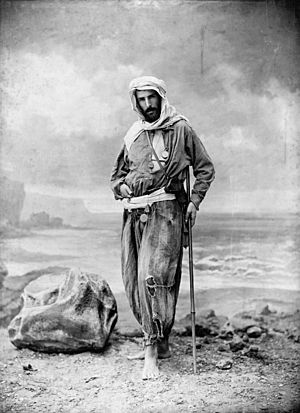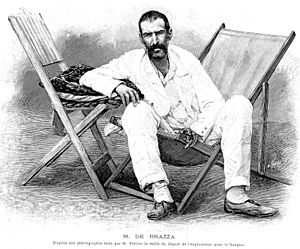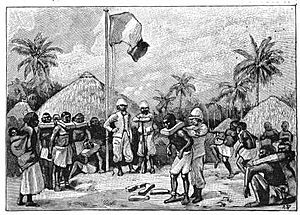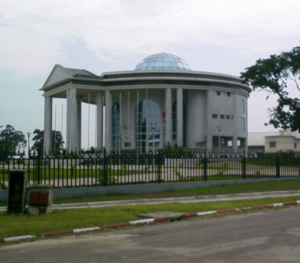Pierre Savorgnan de Brazza facts for kids
Quick facts for kids
Pierre Savorgnan de Brazza
|
|
|---|---|

Pierre Savorgnan de Brazza photographed by Paul Nadar
|
|
| Born |
Pietro Paolo Savorgnan di Brazzà
26 January 1852 Rome, Papal States
|
| Died | 14 September 1905 (aged 53) Dakar, Upper Senegal and Niger, French West Africa
|
| Nationality |
|
| Occupation | Explorer |
| Spouse(s) |
Thérèse Pineton de Chambrun
(m. 1895) |
| Children |
|
| Relatives |
|
Pierre Savorgnan de Brazza (born Pietro Paolo Savorgnan di Brazzà; 26 January 1852 – 14 September 1905) was an Italian-French explorer. He is famous for his journeys in Central Africa.
Many people saw him as a friendly and peaceful person who worked well with the African people he met. However, some recent studies show that he sometimes used clever tricks and even force.
The capital city of the Republic of the Congo is named Brazzaville after him. This name was kept even after the country became independent.
Contents
Early Life

Pietro Savorgnan di Brazzà was born in Rome. He was the seventh of thirteen children. His father was a nobleman and artist. His mother came from an old Roman family.
From a young age, Pietro was very interested in exploring, especially West Africa. He got into the French naval school, the Academy of Borda, in Brest.
In 1870, he finished school and sailed to Algeria. There, he saw a difficult conflict called the Mokrani Revolt. This experience made him believe in using non-violence throughout his life.
Exploring Africa
Brazza first saw Africa in 1872. He was on a French ship that was fighting against slavery near Gabon. He later sailed on another ship, the Vénus, which often stopped in Gabon.
In 1874, Brazza made two trips into the African interior. He traveled up the Gabon River and Ogooué River. He then suggested to the French government that he explore the Ogooué River all the way to where it starts.
With help from important friends, he got some money for his trip. He paid for the rest himself. In 1874, he became a French citizen and changed his name to the French spelling, Pierre Savorgnan de Brazza.
First Expedition (1875-1878)
Brazza's first big expedition lasted from 1875 to 1878. He traveled with only cotton cloth and tools to trade with people. He had a doctor, a naturalist, an assistant, and a small team of African helpers.
He went deep inland, where no other Europeans had gone before. Other explorers had faced resistance from people living along the rivers. But Brazza's brave and peaceful way helped him earn the trust of the local people.
When he returned to Paris, he became very famous. The French newspapers celebrated him. French politicians saw him as the right person to help France expand its influence in Africa.
Second Expedition (1879-1882)
The French government approved a second mission for Brazza. This trip took place from 1879 to 1882. His first mission was seen as a big success. France wanted him to explore the Congo Basin. They wanted to stop Henry M. Stanley, who worked for Leopold II of Belgium, from taking over the whole area.
Brazza followed the Ogooué River upstream. Then he traveled overland to the Lefini River and went downstream. In 1880, he successfully reached the Congo River. He did this without going into areas claimed by Portugal.
Meeting King Makoko
Brazza then met King Makoko Iloo I of the Batéké people. This was a very important meeting for his career. Brazza suggested to King Makoko that his kingdom become a protectorate under the French flag.
King Makoko knew that Stanley was coming. He was also interested in new trade opportunities and wanted an advantage over his rivals. So, he signed the treaty. After the king's death, his queen, Ngalifourou, kept the terms of this treaty. She became a very important person in French colonial life. Brazza respected Ngalifourou so much that he gave her a special sword.
King Makoko also helped set up a French settlement at Mfoa. This place was on the Congo's Malebo Pool and later became known as Brazzaville. After Brazza left, a Senegalese sergeant named Malamine Camara and two helpers stayed at the outpost.
During this trip, Brazza met Stanley near Vivi. Brazza did not tell Stanley about the treaty he had just signed with King Makoko. It took Stanley several months to realize that Brazza had won the "race" to claim the area for France.
Brazza was again celebrated in France for his achievements. The newspapers called him "le conquérant pacifique," which means "the peaceful conqueror." This was because he helped France expand without fighting wars.
Governor of French Congo
In 1883, Brazza was made the governor-general of the French Congo. But in 1897, he was removed from his position. This happened because the colony was not making much money. Also, some journalists reported that the conditions for the native people were "too good."
Brazza himself had become unhappy with how the companies were treating people. He saw that they were exploiting and oppressing the local populations.
By 1905, stories of unfairness, forced labor, and cruelty in the Congo reached Paris. These problems were happening under the new governor, Émile Gentil, who allowed new companies to operate freely. Brazza was sent to investigate these stories.
His report was very detailed and showed many problems, even though people tried to stop him from finding out the truth. When his assistant, Félicien Challaye, presented the report to the French government, it was hidden from the public. The harsh conditions in the French Congo continued for many years.
Personal Life
Brazza's younger brother, Jacques, was a mountaineer and naturalist. He joined Pierre in Africa from 1883 to 1886.
Pierre married Thérèse Pineton de Chambrun in 1895. They had four children: Jacques, Antoine, Charles, and Marthe.
Brazza became a Freemason in 1888. However, he left the group in 1904. He believed that the French Freemasonry had gone against its own values by working with companies that supported an unfair colonial system.
Death and Legacy
In September 1905, Brazza became sick during his last mission. On his way back to France, his ship stopped in Dakar. He was taken to a hospital there and died at age 53, with his wife Thérèse by his side.
His body was brought back to France, and he had a state funeral in Paris. Thérèse always believed her husband was poisoned by the colonial authorities. She refused to have him buried in the Pantheon, a famous monument. Instead, she buried him temporarily in the cemetery of Père Lachaise in Paris.
Later, Thérèse had Brazza's body moved and reburied in Algiers, the capital of present-day Algeria. The words on his tomb in Algiers say: "Une mémoire pure de sang humain" ("a memory untainted by human blood").
Tributes
Some animals are named in his honor, like the fish Enteromius brazzai and the catfish Atopochilus savorgnani. (His brother Jacques has the De Brazza's monkey Cercopithecus neglectus and the plant Pentadiplandra brazzeana named after him.)
A French Navy ship, the Savorgnan de Brazza, was completed in 1933 and named after him.
Brazzaville Mausoleum
In February 2005, the presidents of Congo, Gabon, and France gathered for a ceremony. They laid the first stone for a memorial to Pierre de Brazza. This memorial is a mausoleum made of Italian marble.
On 30 September 2006, Brazza's remains were moved from Algiers, along with those of his wife and four children. They were reburied in Brazzaville on 3 October. This new marble mausoleum cost about $10 million. Three African presidents and a French foreign minister attended the reburial ceremony. They honored Brazza's work against slavery and the abuse of African workers.
See also
 In Spanish: Pierre Savorgnan de Brazza para niños
In Spanish: Pierre Savorgnan de Brazza para niños




